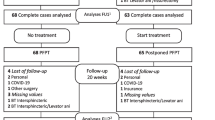Abstract
Background
The therapy of pelvic floor dyssynergia is mostly conservative and is based on a high-fiber diet, physical activity and biofeedback training. Our aim was to compare the outcome of biofeedback (manometric-assisted pelvic relaxation and simulated defecation training) plus transanal electrostimulation with standard therapy (diet, exercise, laxatives).
Methods
Clinical, physiologic and quality of life [patient assessment of constipation quality of life (PAC-QOL)] measures, anorectal manometry and balloon expulsion test results were collected prospectively at baseline, at the end of the treatment and 6 months after treatment. Primary outcome was the modification of the Wexner score for defecation (WS) and the obstructed defecation score (ODS). Secondary outcomes were the modifications of anorectal manometry pattern and quality of life after treatment.
Results
The mean WS and ODS decreased significantly in the EMG biofeedback group: The WS decreased from 16.7 ± 4 to 10 ± 3.5 p < 0.0102, and the ODS decreased from 18.3 ± 5.5 to 5.7 ± 1.8, p < 0.0001. Besides, WS and ODS did not change significantly in the control group. The PAC-QOL score improved significantly from 61 ± 8.6 to 23 ± 4.8 (p < 0.0001) in the EMG biofeedback group; otherwise, the PAC-QOL score did not change significantly in the control group.
Conclusions
Biofeedback therapy plus transanal electrostimulation provided sustained improvement in bowel symptoms and anorectal function in constipated subjects with dyssynergic defecation, whereas standard therapy was largely ineffective.
Similar content being viewed by others
References
Whitehead WE, Wald A, Diamant NE, Enck P, Pemberton JH, Rao SS (1999) Functional disorders of the anus and rectum. Gut 45:II55–II59
Shih DQ, Kwan LY (2007) All roads lead to Rome: update on Rome III criteria and new treatment options. Gastroenterol Rep Winter 1:56–65
Farid M, Yousset T, Mahdy T et al (2009) Comparative study between botulinum toxin injection and partial division of puborectalis for treating anismus. Int J Colorectal Dis 24:327–334
Del Popolo F, Cioli VM, Plevi T, Pescatori M (2014) Psycho-echo-biofeedback: a novel treatment for anismus—results of a prospective controlled study. Tech Coloproctol 18:895–900
Ung KW, Myung SJ, Byeong J (2007) Combined therapy with electrical stimulation and biofeedback in pelvic floor dyssynergia. Neurogastroenterol Motil 19:74
Terra MP, Dobben AC, Berghmans B et al (2006) Electrical stimulation and pelvic floor muscle training with biofeedback in patients with fecal incontinence: a cohort study of 281 patients. Dis Colon Rectum 49:1149–1159
Rao SSC, Tuteja AK, Vellema T, Kempf J, Stessman M (2004) Dyssynergic defecation: demographics, symptoms, stool patterns and quality of life. J Clin Gastroenterol 38:680–685
Rao SS, Seaton K, Miller M et al (2007) Randomized controlled trial of biofeedback, sham feedback, and standard therapy for dyssynergic defecation. Clin Gastroenterol Hepatol 5:331–338
Rao SSC, Valestin J, Brown CK, Zimmerman B, Schulze K (2010) Long term efficacy of biofeedback therapy for dyssynergic defecation: randomized controlled trial. Am J Gastroenterol 105:890–896
Pocock SJ (1983) Clinical trials: a practical approach. Wiley, Hoboken
Heymen S, Scarlett Y, Jones K, Ringel Y, Drossman D, Whitehead WE (2007) Randomized, controlled trail shows biofeedback to be superior to alternative treatments for patients with pelvic floor dyssynergia-type constipation. Dis Colon Rectum 50:428–441
Chiarioni G, Whitehead WE, Pezza V, Morelli A, Bassotti G (2006) Biofeedback is superior to laxatives for normal transit constipation due to pelvic floor dyssynergia. Gastroenterology 130:657–664
Jung KW, Myung SJ, Byeong J (2007) Combined therapy with electrical stimulation and biofeedback in pelvic floor dyssynergia. Neurogastroenterol Motil 19:74
Thompson WG, Longstreth GF, Drossman DA, Heaton KW, Irvine EJ, Müller-Lissner SA (1999) Functional bowel disorders and functional abdominal pain. Gut 45:II43–II47
Jung KW, Yang DH, Yoon IJ et al (2013) Electrical stimulation therapy in chronic functional constipation: five years’ experience in patients refractory to biofeedback therapy and with rectal hyposensitivity. J Neurogastroenterol Motil 19:366–373
Fandel T, Tanagho EA (2005) Neuromodulation in voiding dysfunction: a historical overview of neurostimulation and its application. Urol Clin North Am 32:1–10
Halstead LS, Seager SW, Houston JM, Whitesell RPT, Dennis M, Nance PW (1993) Relief of spasticity in SCI men and women using rectal probe electrostimulation. Paraplegia 31:715–721
Nissenkorn I, Shalev M, Radziszewski P, Dobronski P, Borkowski A, De Jong PR (2004) Patient adjusted intermittent electrostimulation in the treatment of stress and urge urinary incontinence. BJU Int 94:105–109
Conflict of interest
None.
Author information
Authors and Affiliations
Corresponding author
Rights and permissions
About this article
Cite this article
Cadeddu, F., Salis, F., De Luca, E. et al. Efficacy of biofeedback plus transanal stimulation in the management of pelvic floor dyssynergia: a randomized trial. Tech Coloproctol 19, 333–338 (2015). https://doi.org/10.1007/s10151-015-1292-7
Received:
Accepted:
Published:
Issue Date:
DOI: https://doi.org/10.1007/s10151-015-1292-7




